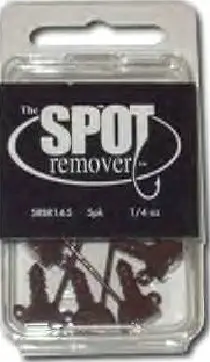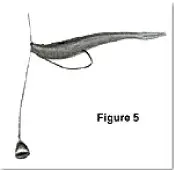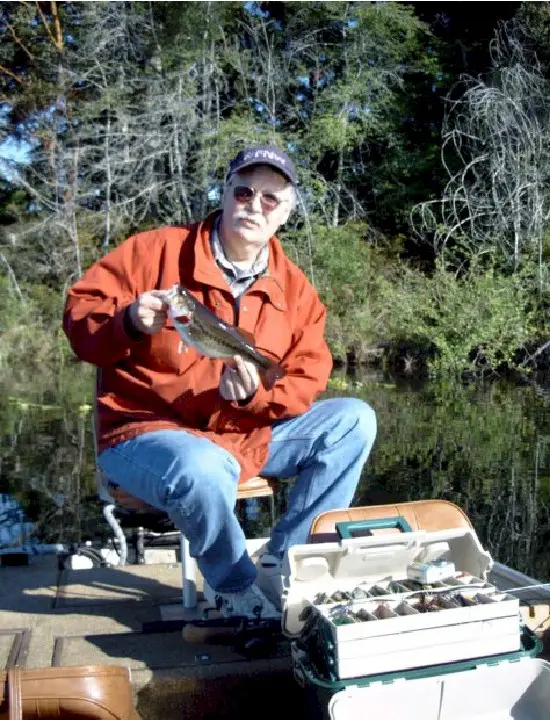Search
Latest Articles
HOW TO FISH SPAWNING BASS
by Bruce Middleton, May 26, 2006
In springtime when the water temperature has risen to about 65 degrees the bass in any given lake begin to start the spawn. This is a most exciting time for most bass fishermen because it is the only time of the year when you can see great quantities of bass in shallow water. I would like to stress here, right up front in the beginning of this article that it is extremely important to release spawning bass as soon as possible as close as possible to their nest. These are not live well bass that you can run around the lake with. Put them back on the nest as soon as you can.
As the water starts to warm the male bass move in to shallow water and begin to build nests. These nests are located in 1 to 10 feet of water normally but some can be deeper depending on the lake and the conditions offered to them. Most bass beds are between one and three feet across and almost perfectly round. They are swept clean of dirt and debris down to bare sand by a fanning action from the tail of the male bass’s tail. When the bed is completely clean, he will guard the nest site and wait until a female comes along and then try to entice her to lay her eggs there. A single two-pound female bass can lay as many as 20,000 eggs with a survival rate of only 5%.
Once the eggs are lain, both male and female will guard the eggs until they hatch. At this time the female will move off into deeper water. The male will stay behind and guard the fry until they are they move into cover and safety or the male simply decides to abandon them after they reach a certain size.
Not all bass start the spawn at the same time! There will be bass in the pre spawn, spawn and post spawn at any given time during this springtime event. This is nature’s way of protecting the species against any cataclysmic weather event that would otherwise wipe out that years entire hatch. The spawn happens over a very long time frame. Also too, not all beds are found on nice soft sandy shorelines. Some are found on trees or on stumps or other hard surfaces. Some are found in deeper than normal water and some are found in other unlikely places like in vegetation. This diversity insures the survival of the species.
During the spawn the bass are under stress, that is they are in unnaturally exposed water with little cover. They are very cautious and eat very frugally. But they are territorial and guard the nest vigorously. This is a real clue as to how to catch them during this time. But then they are also under a lot of fishing pressure. Because they can be seen, fishermen eagerly flock to the lakes to try and catch the biggest bass they can see. Most lakes receive a lot of pressure at this time of year.
In the early morning hours top water lures and spinner baits work well in catching these bedding bass, but multiple casts are often required to any given spot. They are hungry and during low light periods they will feed eagerly. But after the sun comes full up the best way of catching these skittery bass is to rely on their territorial instincts. Soft baits like crawfish and jigs inched into the nest can be seen as a threat to the eggs or young fry and the bass will attack them or sometimes pick them up and remove them to the out side of the nest. This is another important clue as to how to fish for spawning bass. You have to be fast and you have to be able to see your bait at all times..
One thing you will notice right away when fishing for spawning bass, time flies. Moving slowly from one bed to another, watching bass interact with your bait, making multiple cast and many different types of baits, suddenly you realize the day has just gone by and it’s late, much later than you ever thought it was. Watching live bass and interacting with them is one of the most exciting things about the spawn and one I look forward to each year as you will too.
If a bass is just going to pick up a bait and move it out of harms way, he/she is not going to hold on to it very long. Also they have a habit of just picking it up by the tail. If the bass doesn’t have the hook in its mouth then there is no way you can set the hook on it. Now in order to see exactly what is going on with the bass and your offering you have to have two things going for you. One: you have to have a great pair of polarized sunglasses so you can see under the surface and see every detail. And two: you have to be close enough to be able to see the bait, hook and the bass.
Now let me warn you right up front that getting close to a spawning bass without he /she swimming off or getting lock jaw is no easy trick. Your approach must be with the sun at your back if at all possible. This will hide your approach and never get closer than 10 feet to the bass if you can help it. Farther away is better. If you do spook a bass off the bed, move quietly away and wait a few minutes to see if the bass returns. Most will in just a few minutes. A quiet entry with any lure is an absolute must at this time of year. Casting past the bed and working the bait to the edge of the bed is best. Once the bait is at the edge of the bed, begin slowly vibrating the rod tip and ever so slowly working the bait into the center of the bed. Once the bass turns towards the bait, stop. If the bass makes no further move, vibrate the bait again and then let it rest. Eventually the bass will either pick it up or eat it. Scent is an important factor here. Never use unscented baits.
Another great tactic is to use live crawfish on a very short Carolina rig, say one with a 6-inch leader. These mudbugs are a natural enemy of bass eggs and the bass attack them readily. Plastic imitations work just as well if you can impart the right action to them.
I like using preserved minnows at this time too. Since the use of live minnows is unlawful in this state, the preserved ones are a good substitute. Hooked up on a very light jig head and swam right into the nest and dropped head first right into the eggs mass or near it the bass just go nuts trying to get it out of there. I also love to use a ‘spot remover’ jig head.

This jig head has a flat bottom that makes the plastic you use stand straight up. This is like waving a red flag in front of a bull. It worries a bass so much that eventually they just have to strike it or move it out of the bed. Either way you stand a great chance of setting the hook on one of them. Use a short plastic like a four inch black Senko worm, one of my favorites worms at this time of the year.
A drop shot rig is not a normal bedding bass tactic but if you’re going after the biggest bass in the lake, sometimes it pays to be uncommon in your thinking.

The advantage of a drop shot rig is that you can control the movement of the bait without ever having to have the bait leave the nest area. Unlike a Texas or Carolina rig, which you work through a bed and twitch and wiggle in the bottom of the bed, you will finally have to move out of the bed and have to recast it. With a drop shot rig, you can control the movement of the bait but never have to leave the nest. It can stay there all day if you need it too. Again however, the use of invisible line, small baits and smaller hooks is recommended. With the drop shot rig, the idea is to pester the bass into striking the bait. Like a fly buzzing in front of your face, eventually you will swat at it. This tactic also lets the bait hover right at eye level with the bass instead of just lying on the bottom.
With the sinker in the back of the bed or even outside the bed the only important key for you to zoom in on is the distance between the sinker and the bait. This will determine how high the bait is off the floor of the nest in respect to the bass and at the angle the line is to the sinker or how far away you are from the nest. Once you have these factors and are comfortable with the distance so you can see well enough to know when not and to set the hook, you will be able to set the hook at the proper distance up from the sinker.
Now as stated earlier, not all bass will be spawning at the same time and just because you can see about a hundred bass in shallow water spawning doesn’t mean that that is the only way you can catch bass that day. There will be bass in pre spawn in 10 to 15 feet of water on the points, or in the flats waiting to spawn. These bass will be bulking up and getting ready to spawn. These bass are easier to catch, actively feeding and aggressive. Never overlook these bass just because you can see a few in the shallows.
Crank baits and spinner baits along points and drop offs are always a great bet for bass. And never forget your electronics. Be on the lookout for schooling baitfish and bass. Too many bass anglers get so caught up in spawners that they miss some of the better fishing that is out there. Yes it is exciting to see so many big bass in shallow water. But you have to remember they are spooky and very hard to catch.
Pitching and flipping is the name of the game during this stage of the game. You’re making short and very precise casts that require a great deal of accuracy. Long distance casting is not usually required. This is also a light line time or the use of thin tough lines. Also smaller than normal lures and smaller than normal hooks are also advised. The hooks should extra sharp so check them before each use. This is a time for thin as possible lines and invisible lines. This is no place for braided line.
As for colors to use during this time of year on bedding bass it is important to understand that natural colors are very important. Bright colors and colors like white can and will scare a bass off the bed. Stick with greens, blacks and browns, and other natural forage colors. Black and blue jigs work well and finesse black Senko four-inch worms work too. Bubblegum and hot fluorescent colors are diffidently out. Translucent colors work well as do some of the less flashy bleeding bait series.
This is an exciting time to fish for bass. You can glide a boat right up to them and watch great number of huge bass right next to the boat. This only happens for a very small time once a year and is not to be missed. Most people just can’t resist the temptation to try and catch these bass that sit in plain view but some of the best fishing is for those bass that are not yet on the beds.

Bruce Middleton
bpmiddleton@peoplepc.com


